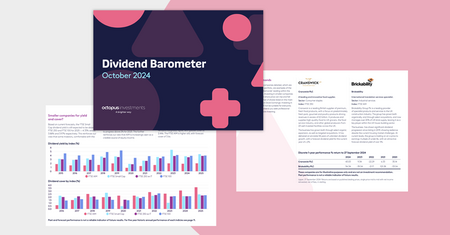Clients looking for high growth investment opportunities
This planning scenario explains how the Octopus Ventures EIS Service could help clients diversify their investment portfolio and benefit from a range
About this scenario
This tax-planning scenario can help advisers develop appropriate planning strategies for their clients.
Advisers should think about the value of tax reliefs for their client. They will also need to consider the impact of charges (including initial fees, ongoing fees and annual management charges) relevant to the products represented and/or any specific product they choose.
Nothing on this page should be viewed as advice. Any suitability decisions should be based on a comprehensive review of your client’s objectives, needs and attitude towards risk. For more details and information about the associated risks, please see the product brochure in our resource centre.
David wants to diversify his investment portfolio into high-growth opportunities
David, 50, is a director in his firm and a high earner. He earns a salary of £170,000 a year plus a bonus, which is £120,000 this year.
David usually invests part of his bonus in long-term investments. He uses his annual pension allowance every year, and has previously invested twice in Octopus Titan VCT – the UK’s largest venture capital trust.*
This year, he wants to use part of his bonus to diversify his long-term investments. He’s looking for something exciting with the potential for high growth, but knows that investments with significant growth potential are typically high risk.
As well as targeting significant returns, David’s passionate about helping small businesses succeed. So he’s keen to use this money to help fund innovative companies and be part of their growth story.
Association of Investment Companies, 30 October 2020
David’s financial adviser suggests investing in EIS qualifying companies
David talks to his financial adviser, who makes an assessment based on David’s:
• Objectives
• Risk appetite
• Attitude towards small company investing
With that in mind, David’s adviser recommends that he invests in the Octopus Ventures EIS Service. It’ll give David shares in 10-15 exciting, early-stage businesses, all selected for their potential to grow by ten times over the next five to ten years.
David knows Octopus from his previous investments in Titan VCT. He’s also aware that Octopus has backed, supported and exited household names like Zoopla, Graze, Secret Escapes and Tails.com.
Tax reliefs
David’s adviser explains that investing in companies aiming for high growth is high risk, and not all early-stage companies succeed. He also says that there are valuable tax reliefs that David could receive, which provides an incentive for the risk.
David can claim 30% tax relief on his investment, which he can offset against his income tax, like the tax on his bonus.
If a company in David’s portfolio achieves high growth, it’ll be free from capital gains tax.
If a company fails, David could claim loss relief against income tax or capital gains, even if his portfolio has increased in value overall. As David’s an additional rate taxpayer, he could claim loss relief at his marginal rate of tax of 45%.
David decides that an EIS portfolio is an attractive way to make high-risk investments in smaller companies in the pursuit of growth. He chooses to invest £100,000.
Risks to remember when investing in EIS
Capital at risk
EIS is high-risk and should be considered as a long-term investment. The value of an investment can fall or rise. Investors may not get back the full amount they invest.
Tax risks
Tax treatment depends on individual circumstances and can change in the future. Tax reliefs depend on the portfolio companies maintaining their qualifying status.
Volatility and liquidity
The shares of smaller companies could fall or rise in value more than shares listed on the main market of the London Stock Exchange. They may also be harder to sell.
How David’s investment in Octopus Ventures EIS Service works
Initial investment
After he’s paid Octopus’ initial fee and initial dealing fee, David will invest £97,030. For simplicity, we’ve assumed David’s money is invested into five EIS-qualifying companies, each of equal weighting in his portfolio.
In reality, Octopus Ventures EIS Service portfolios usually contain 10-15 companies, and the amount invested into each company may vary.
How David’s income tax relief works
David claims 30% income tax relief totalling £29,110 (£5,822 per company). He’s entitled to claim this relief in the year the investment’s made into each EIS company, or he could carry it back to the previous tax year.
As Octopus will invest in early-stage opportunities as they arise, David’s investments may not all be made in the tax year that he subscribes to the portfolio. He can choose to claim income tax relief for the year that each investment into a portfolio company is made, or choose to carry the relief back to the previous tax year. He chooses to claim relief against his income tax bill for the current year which reduces the tax bill on his £120,000 bonus from £54,000 to £24,890.
The detail behind his tax-free growth
Of the two companies in David’s portfolio that perform really well, one grew by three times the amount David invested and one grew by ten times. This means that of the £38,812 invested in these companies, David receives £137,762 after paying Octopus fees.
The gains made on the sale of these shares are tax-free. If the shares hadn’t been EIS-qualifying, David would have owed a total of £42,111 in capital gains tax at his marginal rate of 20%.
How his loss relief is calculated
Over the years, two of the companies in David’s portfolio fail to succeed, and all of the capital he invested in them is lost. David’s entitled to claim loss relief on his effective loss, which is the amount he invested into each company (£19,406) plus the dealing fees (£194), less the income tax relief claimed (£5,822). This amounts to £13,778 on each failed company.
David chooses to offset the effective losses of £27,556 against his income in the tax year each loss occurred. As an additional rate taxpayer, he gets relief at 45% totalling £12,400. Importantly, David is entitled to claim this relief despite his overall portfolio generating positive returns.
Also, because Octopus’ annual management charge is only paid when a company’s sold for more than the amount invested, David doesn’t pay any of the AMC that’s accrued on these companies during his investment. Similarly the performance fee is only due on the difference between the sales proceeds and the amount invested in companies if they’re sold for a profit. As a result David doesn’t have to pay a performance fee on these companies.
A number of EIS tax reliefs rely on companies maintaining their qualifying status and the investor holding their shares for at least three years. Tax treatment depends on individual circumstances. Investors’ capital is at risk.
Eight years later
Some of the companies in David’s portfolio perform well over the eight years, with two delivering attractive growth when they’re sold. One company never achieves success and simply returns the amount David invested when it’s sold. Two fail completely, losing all of David’s capital.
Overall, David’s £100,000 investment in the service returns £271,684 of proceeds when each company is sold.
Investment results and tax benefits of investing in EIS
Performance of a portfolio of five EIS companies
EIS tax reliefs on David’s portfolio
All growth of the companies in David’s portfolio is free from capital gains tax. Had they not been EIS-qualifying he would have owed a total of £42,111 at a rate of 20%.
*Investing in EIS-qualifying companies is high risk and capital is at risk.
The performance fee is calculated based on the difference between the proceeds from sales and the amount invested into each company. For full details on the fees and charges, please read the Octopus Ventures EIS Service brochure.
This illustrative example should be used for reference only to show the impact of fees and charges on, and the potential tax treatment of, an investment in the service. There is no target for this service so this illustration is based on our experience of investing in smaller companies and an investment in the service may return more or less than this example. The example shows the impact of charges paid to Octopus but it does not include any charges paid to an adviser.
In an illustrative scenario where of five EIS companies, two return the initial amount invested and three lose all value, loss on investment would amount to £61,576, returning £38,424 of the initial amount invested. Income tax and loss reliefs could total £47,710 (if claimed by an additional rate tax payer).
We’re here to support you
If you’ve got a question about this scenario, EIS or anything else please get in touch.
Octopus Ventures EIS Service
A portfolio of 10-15 exciting early-stage businesses with high growth potential, selected by one of Europe’s most established venture capital teams.







